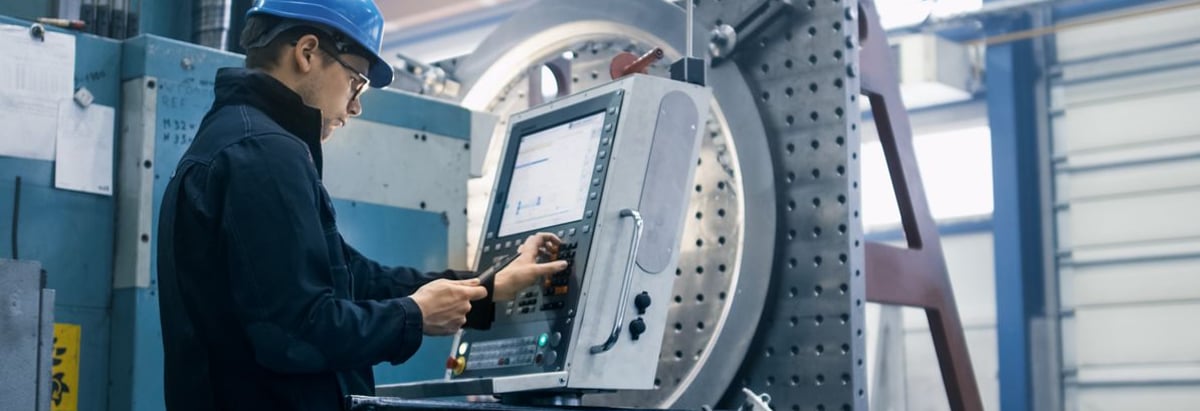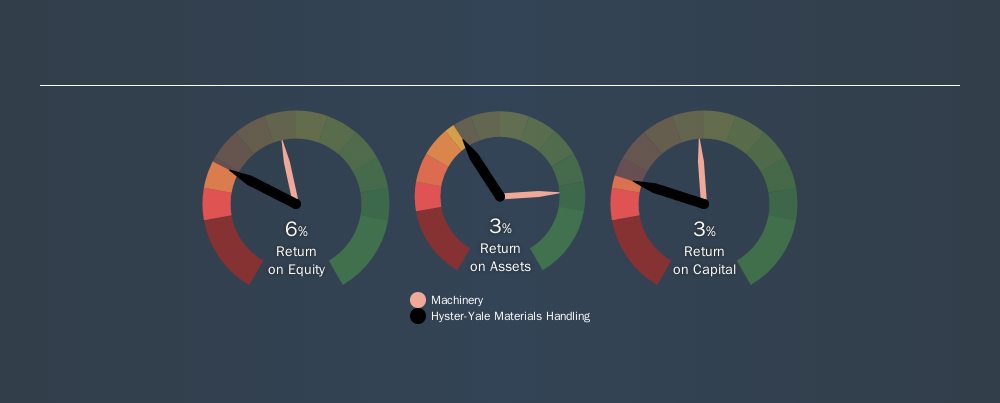- United States
- /
- Machinery
- /
- NYSE:HY
Shareholders Should Look Hard At Hyster-Yale Materials Handling, Inc.’s (NYSE:HY) 3.3%Return On Capital

Today we are going to look at Hyster-Yale Materials Handling, Inc. (NYSE:HY) to see whether it might be an attractive investment prospect. To be precise, we'll consider its Return On Capital Employed (ROCE), as that will inform our view of the quality of the business.
First up, we'll look at what ROCE is and how we calculate it. Then we'll compare its ROCE to similar companies. Last but not least, we'll look at what impact its current liabilities have on its ROCE.
Understanding Return On Capital Employed (ROCE)
ROCE is a measure of a company's yearly pre-tax profit (its return), relative to the capital employed in the business. All else being equal, a better business will have a higher ROCE. Ultimately, it is a useful but imperfect metric. Author Edwin Whiting says to be careful when comparing the ROCE of different businesses, since 'No two businesses are exactly alike.'
So, How Do We Calculate ROCE?
Analysts use this formula to calculate return on capital employed:
Return on Capital Employed = Earnings Before Interest and Tax (EBIT) ÷ (Total Assets - Current Liabilities)
Or for Hyster-Yale Materials Handling:
0.033 = US$35m ÷ (US$1.9b - US$888m) (Based on the trailing twelve months to June 2019.)
So, Hyster-Yale Materials Handling has an ROCE of 3.3%.
View our latest analysis for Hyster-Yale Materials Handling
Is Hyster-Yale Materials Handling's ROCE Good?
ROCE can be useful when making comparisons, such as between similar companies. In this analysis, Hyster-Yale Materials Handling's ROCE appears meaningfully below the 12% average reported by the Machinery industry. This performance could be negative if sustained, as it suggests the business may underperform its industry. Regardless of how Hyster-Yale Materials Handling stacks up against its industry, its ROCE in absolute terms is quite low (especially compared to a bank account). It is likely that there are more attractive prospects out there.
Hyster-Yale Materials Handling's current ROCE of 3.3% is lower than its ROCE in the past, which was 12%, 3 years ago. So investors might consider if it has had issues recently.

When considering this metric, keep in mind that it is backwards looking, and not necessarily predictive. ROCE can be deceptive for cyclical businesses, as returns can look incredible in boom times, and terribly low in downturns. ROCE is only a point-in-time measure. Since the future is so important for investors, you should check out our free report on analyst forecasts for Hyster-Yale Materials Handling.
Do Hyster-Yale Materials Handling's Current Liabilities Skew Its ROCE?
Current liabilities are short term bills and invoices that need to be paid in 12 months or less. Due to the way the ROCE equation works, having large bills due in the near term can make it look as though a company has less capital employed, and thus a higher ROCE than usual. To counter this, investors can check if a company has high current liabilities relative to total assets.
Hyster-Yale Materials Handling has total liabilities of US$888m and total assets of US$1.9b. As a result, its current liabilities are equal to approximately 46% of its total assets. With a medium level of current liabilities boosting the ROCE a little, Hyster-Yale Materials Handling's low ROCE is unappealing.
Our Take On Hyster-Yale Materials Handling's ROCE
This company may not be the most attractive investment prospect. But note: make sure you look for a great company, not just the first idea you come across. So take a peek at this free list of interesting companies with strong recent earnings growth (and a P/E ratio below 20).
I will like Hyster-Yale Materials Handling better if I see some big insider buys. While we wait, check out this free list of growing companies with considerable, recent, insider buying.
We aim to bring you long-term focused research analysis driven by fundamental data. Note that our analysis may not factor in the latest price-sensitive company announcements or qualitative material.
If you spot an error that warrants correction, please contact the editor at editorial-team@simplywallst.com. This article by Simply Wall St is general in nature. It does not constitute a recommendation to buy or sell any stock, and does not take account of your objectives, or your financial situation. Simply Wall St has no position in the stocks mentioned. Thank you for reading.
About NYSE:HY
Hyster-Yale
Through its subsidiaries, designs, engineers, manufactures, sells, and services a line of lift trucks, attachments, and aftermarket parts worldwide.
Undervalued established dividend payer.
Market Insights
Community Narratives



